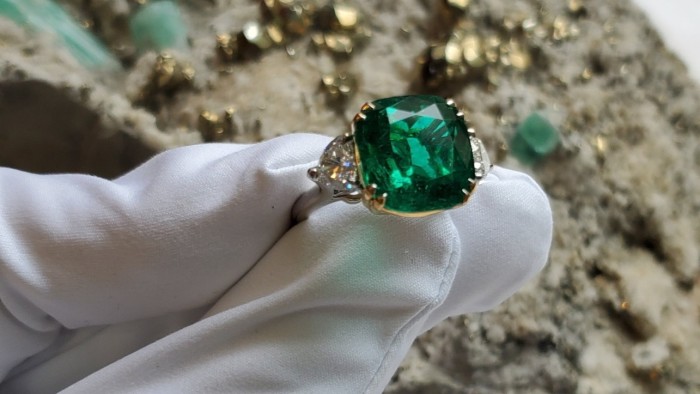Doris Hangartner invites readers of her coffee table book Gem Love Letters to open it randomly and be drawn to the coloured stone that resonates with them most. The Zurich-based gemmologist says it’s fascinating to see people’s outwardly expressed or more guarded personalities match with a charismatic morganite, a calming lavender spinel, or a joyful Paraiba tourmaline.
In this luxurious publication, released at the end of 2024, the jeweller worked with London photographer Leo Bieber to capture her magnificent collection, which ranges from peridot and imperial topaz to garnet species. She says that each thoughtfully curated gem has an intrinsic energy.
While Hangartner feels a deep emotional connection to vibrant gems, she also views rare stones as a strategic financial investment. The daughter of an American nurse and a Swiss banker, she attributes this dual approach to her family legacy. She was one of the early promoters of Paraiba tourmalines, publishing a book on the topic, Purely Paraiba, in 2021. Since then, the neon blue gem has become ubiquitous and prices have rocketed.
Through her gem portfolios, Hangartner works with clients to use gemstones for wealth preservation. With the diamond market in turmoil, only exceptional stones in size and quality, especially coloured diamonds, remain desirable to investors. Meanwhile, outstanding coloured gems command increasingly high prices, as reflected by auction results.

A client appreciating a gem beyond its financial potential enhances its beauty and value, Hangartner says. “If a collector loves a gemstone and they’re gemmologically sound and market-wise the price is good, then there’s a harmony,” she says. “There will always be a value, and the buyers can, at some point, release the stone. If they don’t like the stone and they buy it as a purely commercial investment, I feel there’s not quite that much of a flow.”
Gabriel Ammar, vice-president of global operations at Joseph Gad in New York, adopts a similar approach with the high-net-worth individuals who seek his guidance in acquiring extraordinary emeralds, sapphires, and rubies. “I want [our clients] to buy something they’re going to wear, not park it in the safe. When somebody purchases something to use, they ultimately end up loving it more, and they buy more in the long term,” he says.
Besides acting as a wholesaler of a wide range of high-jewellery brands, Joseph Gad sources top-quality stones in the seven to eight-figure range for private collectors. Ammar advises his clients not to expect a quick-fire gain from their purchase. “[Buying coloured gems] is a long-term investment because these markets don’t shift from one day to the next. It could be five, 10 years before you see a significant increase in value,” he says. “Gemstones are meant to be collected, kept, and passed down. They are things of beauty that when you see one, you don’t see another that’s exactly the same.”
For those seeking to invest in coloured gems, Hangartner recommends making them 5 per cent of a portfolio — with gold at 10 per cent. Jennifer Leitman Bailey, a gemmologist, jewellery appraiser, and adviser in New York City, points out that an item’s financial value is determined by three key factors: market value, rarity, and resale potential. Sentimentality, memories, and personal connections drive emotional value.

“If you make the right purchases — choosing coloured stones, natural over treated, rare colours, significant origins, eye-clean clarity, precise cuts, and of course, size — then both emotional and financial values align harmoniously,” she says. She advises looking at the five-carat-plus range for a stone to be a more substantial financial investment. Ammar says collectors “don’t have to spend $20mn” to acquire a spectacular gem. “The beauty about gems is that there are beautiful stones at every price point. If someone wants to spend $20,000, there will be a beautiful Colombian emerald they can buy that’ll be of investment quality,” he says.
The real test of a gem’s long-term value is when it enters the resale cycle. Jean Ghika, Bonhams global director of jewellery based in London, says it’s challenging to reconcile emotional attachment with financial return. “[Jewels] are often tokens of love, commemoration, celebration. These are highly emotive objects. When you’re having to put pounds or dollars against that emotion, it’s a very difficult match,” she says.

A realistic and fair appraisal can lead to disappointment and re-evaluating the sale. “In many instances, people find it very difficult to realise that there is no financial equivalent to their emotional value. In those instances, they decide that the emotional value is greater, and they retain the item,” Ghika says.
Conversely, some jewels bought for sentimental reasons can prove hot tickets on the second-hand market. Leitman Bailey, who worked at Christie’s before becoming an independent appraiser, evokes a client who purchased important signed jewellery for his wife. Sometime after she passed away, he sold the collection, including an exceptional 42.88-carat emerald brooch from Harry Winston. It went under the hammer for over $1.3mn, almost double its low estimate, in 2014.
“The lesson is that [the collector] bought wisely. The emerald was Colombian, with only minor clarity enhancement, a large size, perfect colour, excellent cut, and eye-clean clarity, among many other qualities. Had he kept it, it would have appreciated in value,” Leitman Bailey says.


